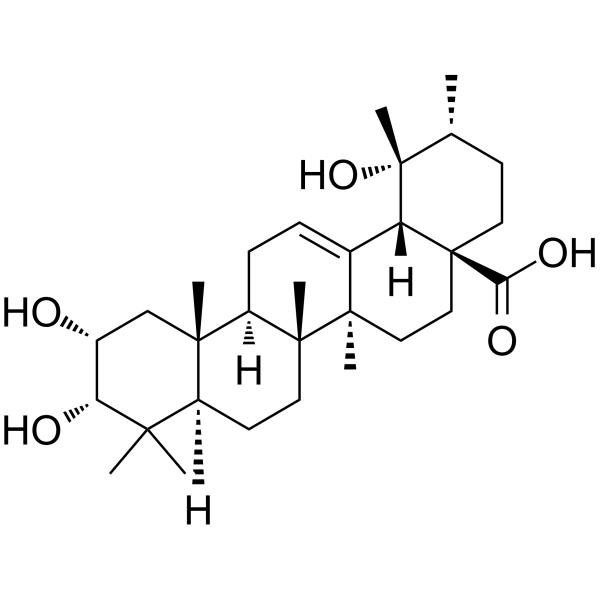上海金畔生物科技有限公司提供天然产物萜类及其苷类Terpenoids and Glycosides。
Euscaphic acid (Synonyms: 野鸦椿酸) 纯度: 98.34%
Euscaphic acid 是源于 R. alceaefolius Poir 的三萜,DNA polymerase 抑制剂。Euscaphic acid 抑制小牛 DNA 聚合酶 α (pol α) 和大鼠 DNA 聚合酶 β (pol β) 的 IC50值分别为 61 和 108 μM。Euscaphic acid 诱导细胞凋亡 (apoptosis)。

Euscaphic acid Chemical Structure
CAS No. : 53155-25-2
| 规格 | 价格 | 是否有货 | 数量 |
|---|---|---|---|
| 1 mg | ¥1300 | In-stock | |
| 5 mg | ¥3800 | In-stock | |
| 10 mg | ¥6500 | In-stock | |
| 50 mg | 询价 | ||
| 100 mg | 询价 |
* Please select Quantity before adding items.
Euscaphic acid 相关产品
•相关化合物库:
- Natural Product Library Plus
- Bioactive Compound Library Plus
- Apoptosis Compound Library
- Cell Cycle/DNA Damage Compound Library
- Kinase Inhibitor Library
- PI3K/Akt/mTOR Compound Library
- Stem Cell Signaling Compound Library
- Natural Product Library
- Anti-Cancer Compound Library
- Autophagy Compound Library
- Anti-Aging Compound Library
- Differentiation Inducing Compound Library
- Lipid Compound Library
- Oxygen Sensing Compound Library
- Terpenoids Library
- Glycolysis Compound Library
- Cytoskeleton Compound Library
- Traditional Chinese Medicine Monomer Library
- Anti-Breast Cancer Compound Library
- Anti-Lung Cancer Compound Library
- Anti-Pancreatic Cancer Compound Library
- Anti-Blood Cancer Compound Library
- Anti-Cancer Metabolism Compound Library
- Angiogenesis Related Compound Library
- Glucose Metabolism Compound Library
- Food-Sourced Compound Library
- Anti-Liver Cancer Compound Library
- Anti-Colorectal Cancer Compound Library
| 生物活性 |
Euscaphic acid, a DNA polymerase inhibitor, is a triterpene from the root of the R. alceaefolius Poir. Euscaphic inhibits calf DNA polymerase α (pol α) and rat DNA polymerase β (pol β) with IC50 values of 61 and 108 μM[1]. Euscaphic acid induces apoptosis[2]. |
IC50 & Target |
IC50: 61 μM (calf DNA polymerase α); 108 μM (rat DNA polymerase β)[1]; apoptosis[2] |
||||||||||||||
|---|---|---|---|---|---|---|---|---|---|---|---|---|---|---|---|---|---|
| 体外研究 (In Vitro) |
Euscaphic acid induces apoptosis and cell cycle arrest in NPC cells by suppression of the PI3K/AKT/mTOR signaling pathway[2]. Shanghai Jinpan Biotech Co Ltd has not independently confirmed the accuracy of these methods. They are for reference only. |
||||||||||||||||
| 分子量 |
488.70 |
||||||||||||||||
| Formula |
C30H48O5 |
||||||||||||||||
| CAS 号 |
53155-25-2 |
||||||||||||||||
| 中文名称 |
野鸦椿酸 |
||||||||||||||||
| 运输条件 |
Room temperature in continental US; may vary elsewhere. |
||||||||||||||||
| 储存方式 |
4°C, sealed storage, away from moisture and light *In solvent : -80°C, 6 months; -20°C, 1 month (sealed storage, away from moisture and light) |
||||||||||||||||
| 溶解性数据 |
In Vitro:
DMSO : 250 mg/mL (511.56 mM; Need ultrasonic) 配制储备液
*
请根据产品在不同溶剂中的溶解度选择合适的溶剂配制储备液;一旦配成溶液,请分装保存,避免反复冻融造成的产品失效。 In Vivo:
请根据您的实验动物和给药方式选择适当的溶解方案。以下溶解方案都请先按照 In Vitro 方式配制澄清的储备液,再依次添加助溶剂: ——为保证实验结果的可靠性,澄清的储备液可以根据储存条件,适当保存;体内实验的工作液,建议您现用现配,当天使用; 以下溶剂前显示的百
|
||||||||||||||||
| 参考文献 |
|
